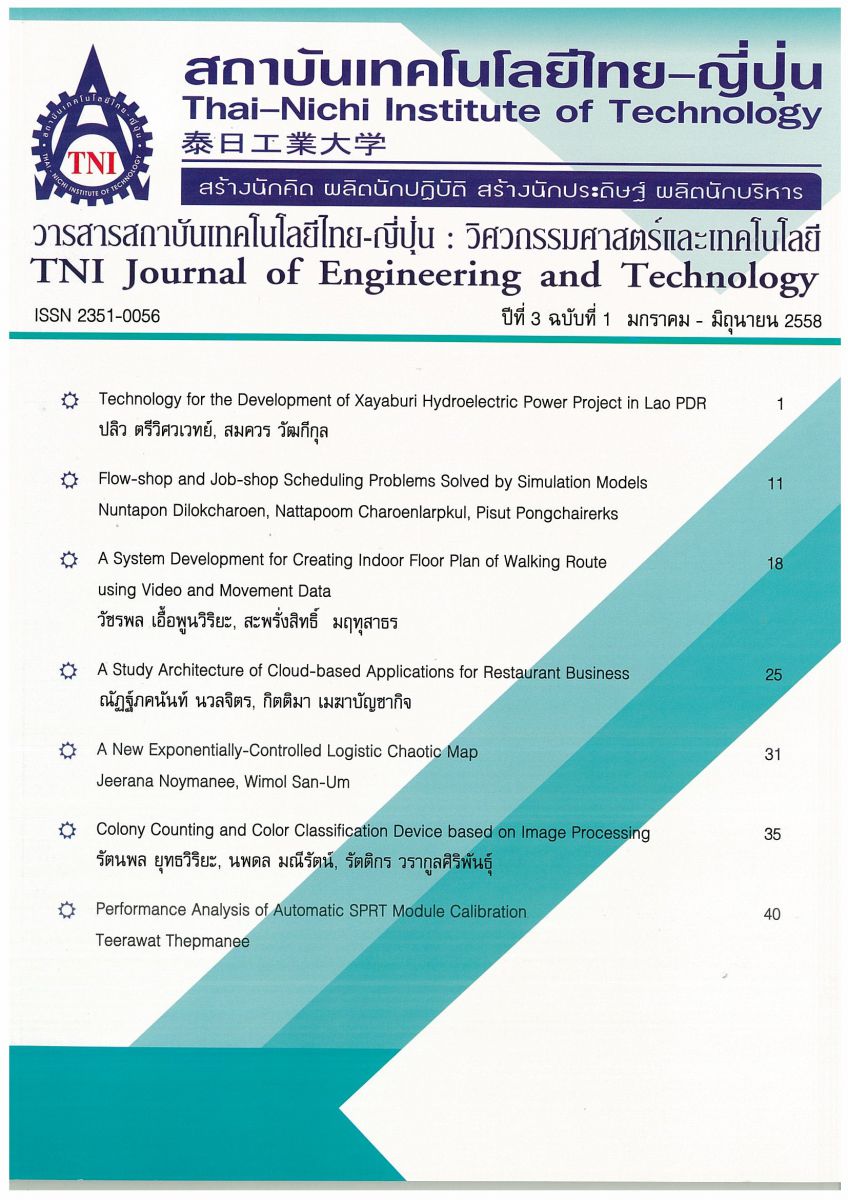Butanol Production from Soybean Hulls by Clostridium saccharobutyricum ATCC BAA117
Main Article Content
Abstract
Butanol Production from Soybean Hulls by Clostridium saccharobutyricum ATCC BAA117 was studied the condition of reducing sugar production of soybean hulls and butanol production from sugar solution by sulfuric acid hydrolysis. The optimal condition is solid/liquid ratio of 1:5 in 5% v/v sulfuric acid at 121oC 15 min high pressure and produce maximum reducing sugar concentration of 31.86 g/L. In addition, By cultivation of Clostridium saccharobutyricum ATCC BAA117 using hydrolysate medium at the optimal initial sugar concentration (30 g/L) at 35oC and pH 5.5, butanal concentration of 11.82 g/L and total solvent of 30.31 g/L
Article Details
Article Accepting Policy
The editorial board of Thai-Nichi Institute of Technology is pleased to receive articles from lecturers and experts in the fields of engineering and technology written in Thai or English. The academic work submitted for publication must not be published in any other publication before and must not be under consideration of other journal submissions. Therefore, those interested in participating in the dissemination of work and knowledge can submit their article to the editorial board for further submission to the screening committee to consider publishing in the journal. The articles that can be published include solely research articles. Interested persons can prepare their articles by reviewing recommendations for article authors.
Copyright infringement is solely the responsibility of the author(s) of the article. Articles that have been published must be screened and reviewed for quality from qualified experts approved by the editorial board.
The text that appears within each article published in this research journal is a personal opinion of each author, nothing related to Thai-Nichi Institute of Technology, and other faculty members in the institution in any way. Responsibilities and accuracy for the content of each article are owned by each author. If there is any mistake, each author will be responsible for his/her own article(s).
The editorial board reserves the right not to bring any content, views or comments of articles in the Journal of Thai-Nichi Institute of Technology to publish before receiving permission from the authorized author(s) in writing. The published work is the copyright of the Journal of Thai-Nichi Institute of Technology.
References
A.Herrera, S. J. Tellez-Luis, Juan J. G. Cabriales, J. A. Ramirez, M.Vazquez. “Effect of the Hydrochliric Acid Concentration on the Hydrolysis of Sorghum Straw at Atmospheric Pressure.” Journal of Food Engineering 63, 2004, pp 103-109.
D.T.Jones, D. R. Woods. Acetone-Butanol Fermentation Revisited. American Society for Microbiology, 1986.
E. Palmqvist, B.H. Hagerdal. “Fermentation of Lignocellulosic Hydrolysates. Ii: Inhibitors and Mechanisms of Inhibition.” Bioresource Technology 74, 2000, pp 25-33.
L. T. Fan, Y. H. Lee, M. M. Gharpuray. “The Nature of Lignocellulosics and Their Pretreatments for Enzymatic Hydrolsis.” Adv. Biochem. Eng. 23, 1982, pp 158-187.
N. Qureshi, X. L. Li, S. Hughes, B. C. Saha and M. A. Cotta. “Butanol Production from Corn Fiber Xylan Using Clostridium Acrtobutylicum.” Biotechnology Progress 22, 2006, pp 673-680.
P. Lenihan, A. Orozco, E. O’Neil, M.N.M. Ahmad, D.W. Rooney, G.M. Walker. “Dilute Acid Hydrolysis of Lignocellulosic Biomass.” Chemical Engineering Journal 156, 2010, pp 395-403.
Xue-bing Zhao, L. W. a. D.-h. L. “Effect of several factors on peracetic acid pretreatment of sugarcane bagasse for enzymatic hydrolysis.” Journal of Chemical Technology and Biotechnology 82, 2007, pp 1115-1121.
Sjolander N.O., Langlykke A.F., Peterson W.H., “Butyl Alcohol Fermentation of wood Suger.” Ind, eng. Chem. 30, 1938, pp 11.
Baugh, K. D. (1983) Rate of formation/decomposition and methane fermentability of autohydrolysis product from lignocellulose, Standford University
Mitchell W.J, Physiology of carbohydrates to solvent conversion by clostridia. Adv Microb Physio, 39, 1998, pp 31-130.


